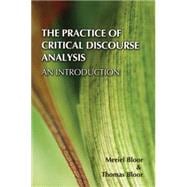
Note: Supplemental materials are not guaranteed with Rental or Used book purchases.
Purchase Benefits
Looking to rent a book? Rent The Practice of Critical Discourse Analysis: an Introduction [ISBN: 9780340912379] for the semester, quarter, and short term or search our site for other textbooks by Bloor,Meriel. Renting a textbook can save you up to 90% from the cost of buying.
| Acknowledgements | p. vii |
| Background and theory | p. 1 |
| This book and how to use it | p. 1 |
| The multidisciplinary nature of CDA | p. 1 |
| Some examples of CDA practice | p. 3 |
| Matters of principle | p. 4 |
| Language and institutions | p. 5 |
| Some basic terms and tools | p. 6 |
| What makes CDA 'critical'? | p. 12 |
| Activities | p. 13 |
| Further study | p. 13 |
| Discourse and social context | p. 15 |
| Sign, context and meaning | p. 15 |
| Language in use | p. 17 |
| Purposeful communication | p. 19 |
| Reference, identity and role | p. 20 |
| Assumptions and the co-operative principle | p. 22 |
| The analysis of context | p. 26 |
| Institutional constraints | p. 29 |
| Activities | p. 30 |
| Further study | p. 31 |
| Positioning and point of view | p. 33 |
| Position and attitude | p. 33 |
| Stance in film and book reviews | p. 34 |
| Stance in a promotional letter | p. 37 |
| Unconscious stance in racist and sexist discourse | p. 43 |
| Stance in history textbooks | p. 45 |
| Some conclusions | p. 47 |
| Activities | p. 47 |
| Further study | p. 49 |
| Intertextual analysis | p. 51 |
| Chains and networks of text | p. 51 |
| Prediction and fact in the media: an example | p. 52 |
| The uses of intertextuality | p. 54 |
| Intertextuality in literature | p. 58 |
| Intertextuality in scientific discourse | p. 60 |
| Expert discourse and issues of power | p. 62 |
| Activities | p. 63 |
| Further study | p. 65 |
| Figurative language, metaphor and message | p. 67 |
| Rhetorical devices in discourse | p. 67 |
| Aristotle's Rhetoric | p. 67 |
| Metaphor | p. 69 |
| Soundbites, slogans and stock phrases | p. 72 |
| Metaphorical framing | p. 75 |
| Analysis: a political article | p. 77 |
| Activities | p. 82 |
| Further study | p. 84 |
| The construction of identity | p. 85 |
| Power and equality | p. 85 |
| Identity and social roles | p. 85 |
| National identity | p. 86 |
| Racial and ethnic identity | p. 87 |
| An example: a racial identity issue | p. 93 |
| Gender identity | p. 94 |
| Gendered discourse | p. 95 |
| Activities | p. 97 |
| Further study | p. 99 |
| Politeness, power and solidarity | p. 101 |
| Non-verbal communication | p. 101 |
| Facework | p. 101 |
| Hedging | p. 103 |
| Politeness | p. 104 |
| Turn-taking | p. 105 |
| Topic control: two television news interviews | p. 107 |
| Spoken and written discourse | p. 113 |
| Desperately seeking solidarity | p. 115 |
| Activities | p. 119 |
| Further study | p. 119 |
| The discourse of prejudice | p. 121 |
| Frames and race | p. 121 |
| Two reports on immigration | p. 123 |
| Prejudice | p. 128 |
| Lexical meaning | p. 129 |
| Lexis and ethnic identity | p. 131 |
| Political correctness | p. 133 |
| Activities | p. 136 |
| Further study | p. 137 |
| The discourse of consumerism | p. 139 |
| Commerce then and now | p. 139 |
| Advertising | p. 141 |
| Analysis: an advertisement | p. 144 |
| Medical science and vested interests | p. 149 |
| The consumerization of education | p. 153 |
| Activities | p. 156 |
| Further study | p. 157 |
| Discourse and the law | p. 159 |
| Equality before the law | p. 159 |
| Disadvantage in court | p. 160 |
| Speech acts in court | p. 166 |
| Forensic linguistics | p. 167 |
| Identical utterances | p. 168 |
| Lexical density | p. 169 |
| Activities | p. 171 |
| Further study | p. 171 |
| Glossary | p. 173 |
| Notes | p. 179 |
| Grammar appendix | p. 183 |
| References | p. 191 |
| Index | p. 201 |
| Table of Contents provided by Ingram. All Rights Reserved. |
The New copy of this book will include any supplemental materials advertised. Please check the title of the book to determine if it should include any access cards, study guides, lab manuals, CDs, etc.
The Used, Rental and eBook copies of this book are not guaranteed to include any supplemental materials. Typically, only the book itself is included. This is true even if the title states it includes any access cards, study guides, lab manuals, CDs, etc.